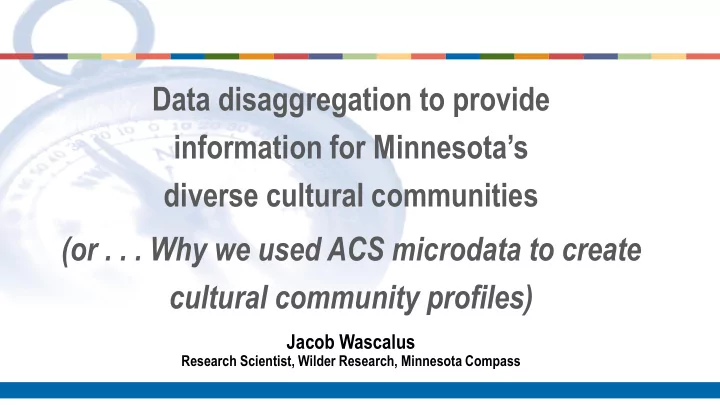

Data disaggregation to provide information for Minnesota’s diverse cultural communities (or . . . Why we used ACS microdata to create cultural community profiles) Jacob Wascalus Research Scientist, Wilder Research, Minnesota Compass
What is Minnesota Compass? mncompass.org
Compass topic areas Arts & Children Aging Civic Engagement Demographics Disparities Culture & Youth Early Childhood Economy Education Environment Health Housing Immigration Public Safety Transportation Workforce
Minnesota’s populations of color 23% 19% of all Minnesotans of all Minnesotans 1.5 million 1.1 million 1% of all Minnesotans 42,000 1960 1970 1980 1990 2000 2010 2017 2020 2030 @MNCompass
Race Racial and ethnic group Detailed racial and ethnic group
How do we construct cultural community profiles?
We use microdata from the most recent 5-year Methodology estimates of the American Community Survey. We considered responses to 5 different questions in the American Community Survey: 1) Is the respondent of Hispanic, Latino or Spanish origin? 2) What is a respondent’s race? 3) What is a respondent’s ancestry or ethnic origins? 4) Where was a respondent born? 5) Add minor children.
Burmese Kenyan Cambodian Korean 23 Cultural Chinese Laotian Community Columbian Lebanese Profiles Cuban Liberian Ecuadorian Mexican + 3 Ethiopian Puerto Rican Filipino Salvadoran Guatemalan Somali Hmong Thai Indian Vietnamese Japanese
U.S. Census Bureau recodes some Limits of responses into broader categories, disaggregation limiting our ability to disaggregate certain groups. For example, people reporting that they are Oromo are recoded under one heading of “Ethiopian.” Karen and Karenni respondents are recoded as “Burmese.”
U.S. Census Bureau suppresses Limits of data tribal affiliation in the microdata for on tribe persons listing multiple races. Results in an inability to accurately include at least 1 in 3 Ojibwe Minnesotans, and about half of Dakota Minnesotans (45%) in these profiles.
+ 3 profiles Native American profile African-American profile White (non-Hispanic)
Thank you! Thank you!
Recommend
More recommend